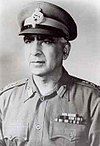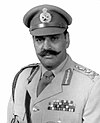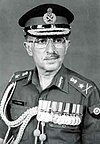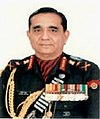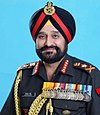Chief of the Army Staff (India)
| Chief of the Army Staff | |
|---|---|
 | |
since 30 June 2024 | |
| Status | Professional head of land forces branch of the Indian Armed Forces. |
| Abbreviation | COAS |
| Member of | Defence Acquisition Council Defence Planning Committee National Security Council |
| Reports to | |
| Seat | Integrated HQ of MoD (Army), South Block, Central Secretariat, New Delhi |
| Appointer | Appointments Committee of the Cabinet (ACC) President of India |
| Term length | 3 years or at the age of 62, whichever is earlier. |
| Constituting instrument | Army Act, 1950 (Act No. 46 of 1950) |
| Precursor | Chief of the Army Staff and Commander-in-Chief, Indian Army |
| Formation | 21 June 1948 |
| First holder | General Rob Lockhart |
| Deputy | |
| Salary | ₹250,000 (US$3,000) monthly[1][2] |
The Chief of the Army Staff (COAS) is a statutory office held by the professional head of the Indian Army (IA), the land forces branch of the Indian Armed Forces.[3] Customarily held by a four-star general officer, the COAS is the senior-most operational officer of the IA, tasked with the roles of overseeing the overall functioning of the force during peace and wartime, committing to the preparation and maintenance of the force's operational effectiveness and defending the nation's territorial integrity and sovereignty.[4]
Being a permanent member of the Chiefs of Staff Committee (COSC) and the National Security Council (NSC), the COAS also bears the responsibility of advising the nation's civilian leadership i.e., the Government of India on all matters privy to the IA.[5]
Statutorily, the COAS ranks 12th-overall in the Indian order of precedence, and is the IA's status-equivalent of the Chief of Defence Staff, the Chief of the Naval Staff and the Chief of the Air Staff - all three positions of which are also occupied by four-star officers from the armed forces.[6]
Description
[edit]
Roles and responsibilities
[edit]Seated at the Integrated Headquarters of Ministry of Defence (Army) (IHQ of MoD (Army)), stationed in New Delhi, the COAS is the senior-most operational officer of the IA, and is tasked with the following:
- Advising the Central Government on all matters privy to the IA.[5]
- Commitment to enhancing the force's capabilities towards sustaining combat readiness and operational effectiveness during periods of peace and conflict.[7]
- Coordinating various components of the IA towards ensuring the protection-cum-realization of the nation's territorial integrity-cum-sovereignty during states of armed conflict or war.[4][8]
- Providing direction towards the overall functioning of the organization's facets, such as command, control, administration and strategy.[9]
- Convening courts-martial at the behest of the Central Government to review cases of misconduct during peace and wartime.[10]
- Reviewing the judicial sentencing and pleas of officers convicted of professional misconduct whilst in service.[10]
In addition to these responsibilities, the COAS is also a permanent member of:
- Chiefs of Staff Committee (COSC)
- National Security Council (NSC)
- Defence Planning Committee (DPC)
- Defence Acquisition Council (DAC)
The office's eminence in the aforementioned groups thus grants the appointee with the role to advise the Minister of Defence (Raksha Mantri or RM) on the affairs related to the IA's functioning and the promotion of an comprehensive integrated planning policy with respect to the affairs of tri-service integration, doctrinal strategy, capability development, defence acquisition and infrastructure.[11][12]
Structure
[edit]As the professional head of the force, the COAS is assisted by one subordinate officer and three principal staff officers, namely:
- Subordinate:
- Vice Chief of Army Staff (VCOAS)
- Principal Staff Officers:[13]
- Deputy Chief of the Army Staff (Capability Development and Sustenance) (DCOAS - CD&S)[14]
- Deputy Chief of the Army Staff (Information Systems and Coordination) (DCOAS - IS&C)[14]
- Deputy Chief of the Army Staff (Strategy) (DCOAS - Strategy)[14]
Promotion
[edit]Beginning in the pre-independence era, the office of COAS has customarily been held by a four-star general.[15] The move to appoint a new designate to the position usually begins three months before the change-of-command, wherein the Ministry of Defence (MoD) reviews the résumés of the IA's sole Vice Chief of Army Staff (VCOAS) and five General Officer Commanding-in-Chiefs (of the force's five combatant commands) - all of whom are lieutenant generals, before making a decision.[16] Appointments to the position are made by the Appointments Committee of the Cabinet (ACC) - comprising the Prime Minister and the Minister of Defence, upon recommendation from the IHQ of MoD (Army); appointees to the office are automatically deemed promoted to the rank of general.[17]
Notably, for the first two decades following India's independence, the C-in-C and the successor COAS were the only four-star officers in the Indian Armed Forces, while the chiefs of the Indian Navy (IN) and Indian Air Force (IAF) were headed by three-star vice admirals and air marshals, respectively; the first chiefs to be promoted to four-star ranks of admiral and air chief marshal occurred in 1968 and 1966, respectively.[18]
Since 1950, the senior-most lieutenant generals in the IA's command cadre have customarily been appointed as COAS, nevertheless, this tradition has been broken twice, first in 1983 - when then-prime minister Indira Gandhi chose to appoint then-Lieutenant General A. K. Vaidya to supersede one senior officer, and in 2016 - when prime minister Narendra Modi chose to appoint then-Lieutenant General Bipin Rawat to supersede two senior officers.[19]
Tenure
[edit]According to the IA's Army Rules, 1954 - a COAS-appointee reaches superannuation upon the completion of three years in the position or at the age of 62, whichever is earlier.[20] However, an appointee may also be dismissed from office by the President of India before the conclusion of the tenure under Section 18-19 of the Army Act, 1950 and Article 310 of the Constitution.[21]
Additionally, the appointee is eligible for an extension in tenure beyond the age of superannuation, as defined by Rule 16 A (4) Army Rules, 1954.[22] However, extensions to serving appointees have been rare, and have only been granted twice since 1947; first in June 1972 to General S. H. F. J. Manekshaw, who received a six-month extension which allowed him to serve until January 1973; and in May 2024 to General Manoj Pande, who received a one-month extension which allowed to serve until June 2024.[22][23]
Previously, in the event of an abrupt stoppage during the incumbent's tenure - by termination, resignation or sudden demise, the senior-most lieutenant-general in IA's command cadre has customarily been appointed as the successor; this situation has occurred twice in the past: first in 1962 - when then-Lieutenant General J. N. Chaudhuri was appointed after the resignation of then-incumbent General Pran Nath Thapar, and again in 1993 - when then-Lieutenant General Shankar Roychowdhury was appointed after the sudden demise of then-incumbent General B. C. Joshi.[24]
Additionally, a COAS-appointee is also eligible to be selected for the position of Chief of Defence Staff (CDS), in accordance with the Army (Amendment) Regulations, 2022 - which prescribes that the designated nominee, in this case the COAS, must be under the age of 62 at the time of appointment as CDS; as of 2024, General Bipin Rawat has been the sole COAS-appointee to be appointed to the position of CDS.[25][26]
History
[edit]Pre-independence era (1748–1947)
[edit]The position's initial roots finds its origins in the 18th century, when the East India Company (EIC) - a British-origin trade establishment and the then-de facto administrative organization of the Indian subcontinent, established the position of Commander-in-Chief, India (C-in-C) in 1748 to head its three Presidency Armies, namely the Bengal Army, the Bombay Army and the Madras Army.[27] Following the 1857-58 Indian rebellion against EIC rule, the control of the Presidency Armies were transferred directly to the British Crown, which succeeded the EIC as the official ruling-cum-governing entity of India. In 1895, the three armies were merged to form a unified British Indian Army (BIA), under the direct control of the C-in-C.[28] Following the Kitchener Reforms in 1903, up until the establishment of India's independence in 1947, the C-in-C functioned as the supreme commander of the armed forces in the subcontinent, liaising directly with the Governor-General of India over the administrative affairs of the stationed military.
Dominion-era (1947–1950)
[edit]Following independence and the subsequent partition of the subcontinent, the BIA was bifurcated into two new entities: the modern-day Indian Army (IA) - responsible for the Dominion of India, and the newly-formed Pakistan Army (PA) - responsible for the Dominion of Pakistan. However, the post of C-in-C was trifurcated into three positions: the C-in-C Indian Army, the C-in-C Pakistan Army and the Supreme Commander India and Pakistan.
Following independence, the IA retained GHQ India, New Delhi - headed by General Sir Rob Lockhart as the first post-independence C-in-C, while the PA established its headquarters at GHQ Pakistan, Rawalpindi - headed by General Frank Messervy (later succeeded by General Sir Douglas Gracey) as its inaugural C-in-C. Nevertheless, the two forces were directed under the auspices of the Supreme Commander's Headquarters (Supreme HQ), headed by Field Marshal Sir Claude Auchinleck, the Supreme Commander. In January 1948, the position of Supreme Commander was abolished and bifurcated into the positions of Commander British Forces in India and the Commander British Forces in Pakistan, located at Bombay and Karachi, respectively, and with the responsibility of overseeing the repatriation of British military units to the United Kingdom.[29] In June 1948, the title of C-in-C was modified with the prefix Chief of the Army Staff, and re-designated as Chief of the Army Staff and Commander-in-Chief, Indian Army (COAS & C-in-C). [30]
In January 1949, upon the impending retirement of General Sir Roy Bucher - the IA's second C-in-C, the Government of India considered the decision to appoint a native Indian general officer to the position; up until then, Indian officers had only achieved the positions associated with the three-star rank of lieutenant general.[31] Three lieutenant-generals were shortlisted as candidates for the position, namely:
- Lieutenant General K. M. Cariappa - General Officer Commanding-in-Chief, Western Command.[19]
- Lieutenant General Nathu Singh Rathore - General Officer Commanding-in-Chief, Eastern Command.[19]
- Lieutenant General S. M. Shrinagesh - General Officer Commanding, XV Corps; also overall commander of Indian troops during the 1947-48 Indo-Pakistani War.[19]
Ultimately, Cariappa was chosen to succeed Bucher, which he did on 15 January 1949, with the substantive rank of a four-star general - which thus made him the first Indian-origin general and first native chief of the Indian Army; the day of his appointment has been commemorated annually ever since as Army Day.[19] Shrinagesh, nevertheless, later served as COAS from 1955 to 1957.[32]
Republic-era (1950–present)
[edit]In 1955, the designation of the position was shortened to simply to Chief of the Army Staff (COAS) through the Commanders-In-Chief (Change in Designation) Act, 1955; as a result of the Act, the tenure of the then-serving C-in-C - General Rajendrasinhji Jadeja, continued under the new designation.[33]
In January 1973, General S. H. F. J. Manekshaw, the Indian Army's seventh COAS, was promoted to the five-star rank of field marshal, in recognition of his leadership during the 1971 Indo-Pakistani War - which made him the only-serving COAS to have ever been promoted to the rank.[34] K. M. Cariappa, the second C-in-C of the Indian Army too was promoted to field marshal thirteen years later, in January 1986; however, unlike Manekshaw, he had superannuated at the rank of general in 1953 and had been in retirement for thirty-three years before his elevation.[31] To note, although a field marshal is nominally the highest-ranking officer in the IA, the rank is all but titular with no operational duties attached, which leaves the COAS as the highest operationally-active officer in the IA.[35]
Appointees
[edit]The undermentioned table chronicles the appointees to the office of Commander-in-Chief, Indian Army (C-in-C) and the successor office of Chief of Army Staff (COAS), beginning from August 1947 to the present-day.[36] Ranks and honours are as at the completion of their tenure:
Commander-in-Chief, British Indian Army (1800–1948)
[edit]| No. | Portrait | Name | Took office | Left office | Time in office | Unit of Commission |
|---|---|---|---|---|---|---|
| 1 | General Sir Robert Mcgregor Macdonald Lockhart, KCB, CIE, MC (1893–1981) [a] | 15 August 1947 | 31 December 1947 | 108 days | 51st Sikhs | |
| 2 | General Sir Francis Robert Roy Bucher, KBE, CB, MC (1895–1980) [a] | 1 January 1948 | 20 June 1948 | 171 days | 4th Cameronians |
Chief of the Army Staff and Commander-in-Chief, Indian Army (1948–1955)
[edit]| No. | Portrait | Name | Took office | Left office | Time in office | Unit of Commission |
|---|---|---|---|---|---|---|
| 1 | General Sir Francis Robert Roy Bucher, KBE, CB, MC (1895–1980) [a] | 21 June 1948 | 14 January 1949 | 208 days | 4th Cameronians | |
| 2 | Field Marshal Kodandera Madappa Cariappa, OBE (1899–1993) | 15 January 1949 | 14 January 1953 | 3 years, 365 days | 88th Carnatic Infantry | |
| 3 | General Maharaj Shri Rajendrasinhji Jadeja, DSO (1899–1964) | 14 January 1953 | 1 April 1955 | 2 years, 77 days | 2nd Lancers (Gardner's Horse)[37] |
Chief of the Army Staff (1955–present)
[edit]| No. | Portrait | Name | Took office | Left office | Time in office | Unit of Commission |
|---|---|---|---|---|---|---|
| 1 | General Maharaj Shri Rajendrasinhji Jadeja, DSO (1899–1964) | 1 April 1955 | 14 May 1955 | 43 days | 2nd Lancers (Gardner's Horse) | |
| 2 | General Satyawant Mallana Srinagesh (1903–1977) | 15 May 1955 | 7 May 1957 | 1 year, 357 days | 19th Hyderabad Regiment | |
| 3 | General Kodandera Subayya Thimayya, DSO (1906–1965) | 8 May 1957 | 7 May 1961 | 4 years, 0 days | 19th Hyderabad Regiment | |
| 4 | General Pran Nath Thapar, PVSM (1906–1975) | 8 May 1961 | 19 November 1962 | 1 year, 195 days | 1st Punjab Regiment | |
| 5 | General Jayanto Nath Chaudhuri, OBE (1908–1983) | 20 November 1962 | 7 June 1966 | 3 years, 199 days | 16th Light Cavalry | |
| 6 | General Paramasiva Prabhakar Kumaramangalam, DSO, MBE (1913–2000) | 8 June 1966 | 7 June 1969 | 2 years, 364 days | Regiment of Artillery | |
| 7 | Field Marshal Sam Hormusji Framji Jamshedji Manekshaw, MC (1914–2008) | 8 June 1969 | 15 January 1973 | 3 years, 221 days | 8th Gorkha Rifles | |
| 8 | General Gopal Gurunath Bewoor, PVSM (1916–1989) | 16 January 1973 | 31 May 1975 | 2 years, 135 days | Dogra Regiment | |
| 9 | General Tapishwar Narain Raina, MVC, SM (1921–1980) | 1 June 1975 | 31 May 1978 | 2 years, 364 days | Kumaon Regiment | |
| 10 | General Om Prakash Malhotra, PVSM (1922–2015) | 1 June 1978 | 31 May 1981 | 2 years, 364 days | Regiment of Artillery | |
| 11 | General Kotikalapudi Venkata Krishna Rao, PVSM (1923–2016) | 1 June 1981 | 31 July 1983 | 1 year, 364 days | Mahar Regiment | |
| 12 | General Arunkumar Shridhar Vaidya, PVSM, MVC, AVSM (1926–1986) | 1 August 1983 | 31 January 1986 | 2 years, 244 days | The Deccan Horse (9 Horse) | |
| 13 | General Krishnaswamy Sundarji, PVSM (1928–1999) | 1 February 1986 | 31 May 1988 | 2 years, 120 days | Mahar Regiment | |
| 14 | General Vishwa Nath Sharma, PVSM, AVSM, ADC (born 1930) | 1 June 1988 | 30 June 1990 | 2 years, 29 days | 16th Light Cavalry | |
| 15 | General Sunith Francis Rodrigues, PVSM, VSM (1933–2022) | 1 July 1990 | 30 June 1993 | 2 years, 364 days | Regiment of Artillery | |
| 16 | General Bipin Chandra Joshi, PVSM, AVSM, ADC (1935–1994) | 1 July 1993 | 19 November 1994 | 1 year, 141 days | 64th Cavalry | |
| 17 | General Shankar Roy Chowdhary, PVSM, ADC (born 1937) | 20 November 1994 | 30 September 1997 | 2 years, 314 days | 20th Lancers | |
| 18 | General Ved Prakash Malik, PVSM, AVSM (born 1939) | 1 October 1997 | 30 September 2000 | 2 years, 365 days | Sikh Light Infantry | |
| 19 | General Sundararajan Padmanabhan, PVSM, AVSM, VSM (1940–2024) | 1 October 2000 | 31 December 2002 | 2 years, 91 days | Regiment of Artillery | |
| 20 | General Nirmal Chander Vij PVSM, UYSM, AVSM (born 1943) | 1 January 2003 | 31 January 2005 | 2 years, 30 days | Dogra Regiment | |
| 21 | General Joginder Jaswant Singh, PVSM, AVSM, VSM, ADC (born 1945) | 1 February 2005 | 30 September 2007 | 2 years, 241 days | Maratha Light Infantry | |
| 22 | General Deepak Kapoor, PVSM, AVSM, SM, VSM, ADC (born 1948) | 1 October 2007 | 31 March 2010 | 2 years, 181 days | Regiment of Artillery | |
| 23 | General Vijay Kumar Singh, PVSM, AVSM, YSM, ADC (born 1950) | 1 April 2010 | 31 May 2012 | 2 years, 60 days | Rajput Regiment | |
| 24 | General Bikram Singh PVSM, UYSM, AVSM, SM, VSM, ADC (born 1952) | 1 June 2012 | 31 July 2014 | 2 years, 60 days | Sikh Light Infantry | |
| 25 | General Dalbir Singh Suhag, PVSM, UYSM, AVSM, VSM, ADC (born 1954) | 1 August 2014 | 31 December 2016 | 2 years, 152 days | 5th Gorkha Rifles | |
| 26 | General Bipin Rawat, PVSM, UYSM, AVSM, YSM, SM, VSM, ADC (1958–2021) | 31 December 2016 | 31 December 2019 | 3 years | 11th Gorkha Rifles | |
| 27 | General Manoj Mukund Naravane, PVSM, AVSM, SM, VSM, ADC (born 1960) | 31 December 2019 | 30 April 2022 | 2 years, 120 days | Sikh Light Infantry | |
| 28 | General Manoj Pande, PVSM, AVSM, VSM, ADC (born 1962) | 30 April 2022 | 30 June 2024 | 2 years, 61 days | Bombay Sappers | |
| 29 | General Upendra Dwivedi, PVSM, AVSM, ADC (born 1964) | 30 June 2024 | Incumbent | 145 days | Jammu and Kashmir Rifles |
See also
[edit]Former command offices
[edit]Other offices of the Indian Armed Forces
[edit]- Chief of Defence Staff
- Chairman of the Chiefs of Staff Committee
- Chief of Integrated Defence Staff
- Chief of the Naval Staff
- Chief of the Air Staff
History
[edit]Notes
[edit]- ^ a b c Formerly British Indian Army. Seconded from the British Army.
References
[edit]- ^ "Report of the 7th Central Pay Commission of India" (PDF). Seventh Central Pay Commission, Government of India. Archived from the original (PDF) on 20 November 2015. Retrieved 13 August 2017.
- ^ Biswas, Shreya, ed. (29 June 2016). "7th Pay Commission cleared: What is the Pay Commission? How does it affect salaries?". India Today. Retrieved 24 September 2017.
- ^ "Chief of the Army Staff". indianarmy.nic.in.
- ^ a b "Army capable of safeguarding security of country: Army chief". 8 June 2013.
- ^ a b "The Civil and the Military in India". www.theindiaforum.in. 12 February 2020.
- ^ "PRESIDENT'S SECRETARIAT" (PDF). www.mha.gov.in. 26 July 1979.
- ^ "Gen Upendra Dwivedi becomes chief of 1.3 million-strong Army". www.deccanherald.com. 30 June 2024.
- ^ "Stand with Army, threat to territorial integrity will be fought with equal force: Ladakh MP". timesofindia.indiatimes.com. 24 June 2020.
- ^ "Indian Armed Forces". knowindia.india.gov.in.
- ^ a b "The Army Act, 1950" (PDF).
- ^ "Civil-military relations in Independent India". www.orfonline.org. 15 August 2022.
- ^ "CDS Rawat to face hurdles & sabotage unless rules are rewritten". www.orfonline.org. 2 January 2020.
- ^ "Deputy Chief of Army Staff (DCOAS)". indianarmy.nic.in. Retrieved 12 January 2022.
- ^ a b c "Army HQ is in the middle of a makeover, and these are the changes introduced so far". theprint.in. 6 April 2021.
- ^ "India to now get chief of defence staff, will be a 4-star general". timesofindia.indiatimes.com. 25 December 2019.
- ^ "In Bucking Army Seniority, Modi Takes a Leaf from Pakistani Playbook". thewire.in. 20 December 2016.
- ^ "Due process followed in selection and appointment of Army chief, say defence ministry sources". timesofindia.indiatimes.com. 18 January 2016.
- ^ "Part I-Section 4: Ministry of Defence (Navy Branch)" (PDF). The Gazette of India. 23 March 1968. p. 245.
- ^ a b c d e "Selection of Army Chief" (PDF). spsindia.in.
- ^ "Army Rules, 1954" (PDF). www.mod.gov.in.
- ^ "Article 310 in Constitution of India". indiankanoon.org.
- ^ a b "In an Unusual Move, Govt Extends Army Chief General Pande's Tenure by One Month". thewire.in. 27 May 2024.
- ^ "Domestic, Regional Implications of Pakistani Army Chief's Term Extension". thewire.in. 23 August 2019.
- ^ "India's army chief is dead". www.upi.com. 18 November 1994.
- ^ "Cabinet approves creation of the post of Chief of Defence Staff in the rank of four star General". Press Information Bureau, Government of India. 24 December 2019. Retrieved 25 December 2019.
- ^ "MINISTRY OF DEFENCE (Department of Defence) NOTIFICATION" (PDF). assettype.com.
- ^ Jackson, Major Donovan (1940). India's Army. London: Low, Marston. pp. 1–8.
- ^ "Southern Command History". Indianarmy.nic.in. Retrieved 4 January 2010.
- ^ "Press Communique - 12 November 1947 (Page 3)" (PDF). Press Information Bureau of India - Archive. 10 November 1947. Retrieved 19 July 2020.
- ^ "Press Communique" (PDF). Press Information Bureau of India - Archive. 21 June 1948. Retrieved 18 June 2023.
- ^ a b Singh 2005, p. 38.
- ^ "Army generals surprise late chief's wife on her 99th birthday". www.hindustantimes.com. 15 August 2014.
- ^ "The Commanders-In-Chief (Change in Designation) Act, 1955". VakilNo1.com. Archived from the original on 11 November 2011. Retrieved 18 October 2011.
- ^ "Part I-Section 4: Ministry of Defence (Army Branch)" (PDF). The Gazette of India-Extraordinary. 2 January 1973. p. 1. Archived from the original (PDF) on 6 February 2023.
- ^ "Rank for Indian Army". atharvafoundation.in.
- ^ Official Indian Army Web Portal. "Chief of the Army Staff (COAS)". www.indianarmy.nic.in. Archived from the original on 18 July 2021. Retrieved 18 July 2021.
- ^ Contibutor, Bharat Rakshak - Indian Army & Land Forces. "General Maharaj Kumar Shri Rajendrasinhji DSO". www.Bharat-Rakshak.com. Archived from the original on 11 January 2018. Retrieved 18 July 2021.
Sources
[edit]- Khanduri, Chandra B. (2006). Thimayya: an amazing life. New Delhi: Knowledge World. p. 394. ISBN 978-81-87966-36-4. Retrieved 30 July 2010.
- Singh, V. K. (2005). Leadership in the Indian army: biographies of twelve soldiers. SAGE Publications. ISBN 978-0761933229.








